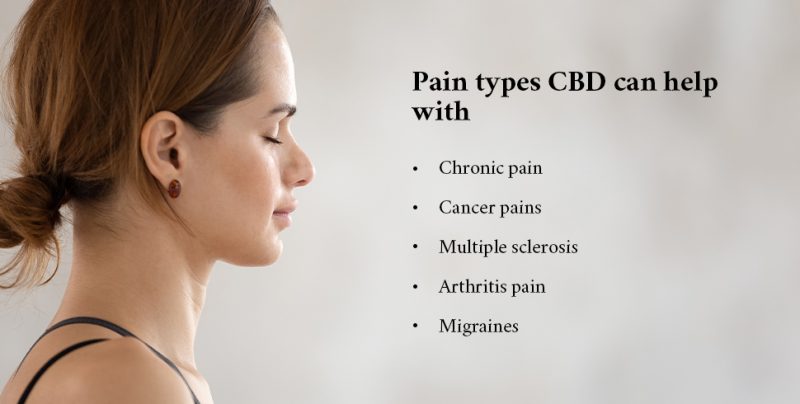
We all have so many questions about CBD, one is does CBD Oil for Pain work or is it a gimmick? Let’s be honest, Pain affects so many people in one form or another anything that can help is a real relief! The evidence is mounting that CBD, a cannabinoid from the cannabis plant and medical cannabis may be the answer to some people’s pain. Let’s take a look a Pain and Cannabis.
First, what is pain?
The current medical definition is
“An unpleasant sensory and emotional experience associated with actual or potential tissue damage,”
International Association for the Study of Pain (IASP)

A little dry may be, but this definition characterises show some of the real issues around describing pain. It is a complex and sensory and emotional experience we all feel differently. This is due to the way pain is experienced in the body. Let’s follow the path of a pain signal and see just what happens. Imagine a needle prick on a finger, the nerve endings with special pain receptors called nociceptors activate.
These receptors are part of the sensory nerve system and send an electrical impulse to the central nervous system – the spinal cord and brain. This signalling network passes the impulse to a region in the brain called the thalamus for central processing. The thalamus switchboard then routes signals to other regions of the brain for final processing. These brain regions then respond and transmit return signals back to the nerve endings, so an action takes place. This whole process happens in fractions of a second and this signalling network leads to all of us feeling pain in different ways with different pain thresholds.
For those that develop intense or constant pain from the body’s receptors, it can profoundly alter daily life.
The excruciating feeling of pain that the brain can focus on, in certain cases can provide a desperate backdrop to even the most mundane of tasks. Medications such as opioids act by interacting with the opioid receptors in the spinal column and brain to block or muffle pain signals. The treatment options for pain management revolve around either blocking the receptor sensation at sites of pain so they don't trigger, or intercepting the signals as they travel along the nerve highways. The final method is to block the processing centre in the brain where pain is actually perceived.
Once the brain has received and interpreted the pain message, it coordinates an appropriate response. The brain can send a signal back to the spinal cord and nerves to increase or decrease the severity of pain.
Cannabinoids suppress pain responses by adjusting the effects of other neurotransmitter systems, such as the noradrenaline system and the GABAergic system to reduce the perception of pain. The nature of cannabinoids helps to reduce inflammation in the body while the antioxidant properties help slow cell damage.
You may be interested in our blog on : Cannabis Could Help Treat OCD
Table of Contents
So what is CBD?
To start we need to look at history, cannabis has always been used for its therapeutic and healing properties. Cannabis and extracted CBD oil for pain were used by the Ancient Greeks, as well as the Egyptians and even by Arabic physicians. The 20th Century saw a real change, with industrialised pill medications replacing plant-based treatments so Cannabis fell out of favour. It is only recently in the 21st century that we have started going back to the future to find more holistic approaches. Cannabis science is making a resurgent comeback and developing technology to extract a whole range of cannabinoids in new ways. Scientifically known as Cannabidiol, CBD is one of over 100 cannabinoids found in the cannabis plant.
CBD is known to be an analgesic, anti-inflammatory, anti-convulsant with anxiolytic effects. The molecule interacts with many receptors in the body. The most famous of them being the CB1 and CB2 receptors in the endocannabinoid system. CBD actually acts to inhibit the uptake of the bodies own endocannabinoids called Anandamide and 2AG. The fact is CBD interacts with many other important sites including the Serotonin and vanilloid receptors in the body that influence pain perception. As you can see there are complex interactions at play which is why research is uncovering so much potential around CBD.
The growing number of clinical trials looking to examine many of the medical applications of CBD & Cannabis are now showing positive results. The changes in legislation across the world are allowing more research and driving people to look at CBD & medical cannabis for pain management and pain relief so let’s take a look.
Read more in detail here : What is CBD?
CBD Oil for pain – What Pain types can help with?
Research has shown that cannabidiol oil can help treat numerous forms of pain in a wide variety of patients, including back pain, cancer pain, fibromyalgia pain, arthritis, and migraines. Up until recently, patients were relying on anecdotal evidence and incomplete research. Now that these clinical trials into the benefits of CBD oil and medical cannabis are showing positive outcomes, scientists are conducting in-depth research to find definite applications of CBD.
Please note we do not offer medical advice but would always suggest It is best to speak to a specialist medical professional to see if CBD or medical cannabis can help you.

Chronic pain
Chronic pain can be utterly debilitating. It is a condition of the central nervous system where the pain goes beyond the normal timeline of healing. Chronic pain can affect numerous parts of the body. Back pain is a common form of chronic pain that some patients deal with for a long time. This can be a result of a fall or injury and manifests itself as either a sharp or dull localised pain. CBD’s interactions help reduce pain signalling and reduce inflammation.
Research https://www.cmaj.ca/content/182/14/E694
Cancer pains
Cancer patients must deal with an enormous amount of pain and discomfort, particularly if they opt for chemotherapy. The regulation and evidence around the world are showing that some cancer patients can benefit from CBD oil & medical cannabis. Relief from some pain but also the symptoms that traditional treatments can induce like nausea as CBD can lower the amount of serotonin released, to help reduce how often vomiting controls in the brain are stimulated.
Research https://www.ncbi.nlm.nih.gov/pmc/articles/PMC3165951/
Multiple sclerosis
Cannabidiol has also been used to treat multiple sclerosis and other neurological diseases for centuries. We now know this is because of its antioxidant and neuroprotective properties. This has led to patients using cannabidiol products to try to reduce the pain and seizures associated with multiple sclerosis then moving to full medical cannabis if CBD alone did not prove effective.
Read our similar article on : CBD Oil for Multiple Sclerosis
Arthritis pain
People with rheumatoid arthritis and osteoarthritis have been using CBD oil to help treat their joint pain. This is because as we discussed before CBD oil interacts with the CB2 receptor in our brains to help reduce the signalling of neurotransmitters reducing the chronic pain signals and inflammation. Topical CBD oil can also be directly applied to the afflicted area to relieve joint pain which helps it to be quickly absorbed. Here many use CBD oil for pain, and many say it is very effective.
Read our similar article on : Medical Cannabis for Arthritis
Migraines
It is these anti-inflammatory and pain-reducing properties that attract migraine sufferers to CBD. While it’s easy to see why people with migraines turn to CBD for pain relief medical cannabis with the added cannabinoids can be even more effective.
Now that we know some of the many applications of cannabidiol oil you might be wondering – what’s the best way to take CBD oil for pain related symptoms and other uses?
Best ways to take CBD oil
CBD oil can be taken in a number of forms. This makes it very adaptable and should allow most users to find a method to suit their needs and lifestyle.

Each of these delivery methods has varying onset times so it really depends on why you want to take CBD as to which way will work best for you. Edibles tend to take longer to act but have a longer-lasting effect.
Any inhalation method you use will have a quicker onset time but will have a shorter effect time. Topicals tend to have a much more localised effect but can enter the bloodstream depending on the amount applied and strength of the product.
1. Capsules
If you’re concerned about getting the correct dose every time then you might want to consider using capsules. Capsules come in exact doses that are clearly stated on the bottle. However, they do take longer to enter the bloodstream than other methods.
2. Tinctures
This is probably the most common method to consume CBD oil. The CBD is mixed with a carrier oil and sold in small bottles with a dropper. Tinctures are discreet and easy to use. They are one of the fastest ways to use CBD oil for pain because the oral mucosal membranes are thin with good blood flow beneath them so the CBD will enter the bloodstream quicker. The same is true of Medical Cannabis tinctures.
3. Edibles
CBD can also be integrated into baking and cooking making edibles. Cannabidiol oil can be added to salad dressings and easily integrated into daily life. Others enjoy CBD infused gummies, cookies and brownies. A popular way for many people, just mind the calories!
Read our similar article on : CBD Edibles UK
4. Topicals
If you need fast-acting CBD Oil for pain related symptoms in a precise location then you may want a topical solution. CBD-infused creams, oils and CBD balms can be directly applied to sore joints and muscles.
5. Vaping
If you currently vape then it's probably best to continue vaping CBD. It works just like other vaping fluid, except this comes with all the benefits of CBD! You can also get CBD flower to vape on medical cannabis prescriptions.
Read our similar article on : CBD Dosage guide
CBD side effects
It’s easy to see the benefits and uses of CBD, but we should all exercise some caution though. CBD has many benefits of cbd and some side effects to be aware of. CBD effects everyone differently so it’s important to pay attention to how it affects you.

This includes, but is not limited to:
- Dry mouth
- Anxiety
- Weight change
- Diarrhoea
Dry mouth
One of the most common side effects associated with using CBD is dry mouth or cottonmouth. This happens as CBD can affect the salivary glands. The glands are inhibited from working so the mouth is left dry and sticky. To combat this you should drink lots of water and chew on xylitol gum.
Anxiety
CBD is used by some to treat anxiety, but ironically, it can also cause anxiety in some people. It is thought that CBD can change the blood flow in areas of the brain that deal with anxiety which can increase anxiety for some people. Without further testing and research, the link between the two is still unclear.
Weight change
CBD has been known to cause both an increase and decrease in weight for users. CBD can help boost metabolism in some people which can lead to unwanted weight loss. During medical trials to investigate the relationship between CBD and epilepsy, scientists found that some patients had an increase in appetite.
Diarrhoea
Large doses of CBD have been attributed to causing diarrhoea in some people. This is caused, not by the CBD itself, but by impurities in the production process and its carrier oil.
It should be noted that the UK Food standards agency has recently recommended a maximum daily dose of 70mg/day.
Read our similar article on : CBD Benefits and SIde effects
CBD massages – Are they worth it?
The benefits of getting a massage have been well known for a long time now. They can be relaxing, therapeutic and help ease the pain. Masseuses use CBD massage oil just like regular oil on sore areas. The CBD massage oil is thought to directly affect the pain in the muscles while also acting as an anti-inflammatory. One of the main benefits of using massage oil is that you can help avoid some of the potential negatives from consuming CBD orally.
Now that we’ve seen the uses and benefits of CBD oil how do we choose the correct dosage?
Optimal dosage of CBD Oil for Pain
As CBD affects everyone differently, it can be hard to find the correct dose that works for you. When first starting off with CBD, it is highly recommended that you speak with your doctor or professional for sound medical advice. They will recommend a dosage, to begin with.
They will use your body weight, body composition and condition being treated to estimate a good starting dose. Too low of a dose and you will see no benefit, too high and you might suffer from some side effects.
If using a CBD tincture you will need to figure out how much CBD there is per drop. This may seem daunting at first, but it's actually quite straightforward. Let’s say the label on a tincture says it contains 2000 mg of CBD and the bottle has 20 ml of CBD oil in it. If one drop equals 0.05ml then you have 400 drops per 20 ml. If you have 400 drops that contain 2000 mg of CBD then 1 drop has 5 mg of CBD.
Education is one of the areas that the CBD industry and law enforcers must focus on. When chatting with friends about CBD oil I’m sure you’ve had friends ask if it’s legal.
Is it legal to take CBD Oil for pain?
Laws across the world regarding CBD and cannabis products seem to be changing quite regularly. In the EU countries like Luxembourg have stated their intent to relax laws for recreational cannabis consumption. While Canada has completely legalised cannabis and is reaping the rewards because of it.
Currently in the UK for a CBD product to be legally sold it must have a THC content level of 0.2% or less. THC is the psychoactive part of cannabis that gets you ‘lifted’. When buying CBD products it is imperative that the labelling states how much CBD is in it and whether or not it has been tested by a third party. You can buy CBD products legally in shops and online throughout the UK.
Medical cannabis for pain management is an option that many are looking at now. CBD can be effective for many. However, medical cannabis prescriptions allow patients to access full-spectrum products that have the additional therapeutic benefits that have been shown with the addition of THC. This is called the entourage effect which research has shown makes the products more effective because they have all the components of the Cannabis plant. The existence of organisations like AccessKaneh can offer advice on accessing cannabis for pain relief.
Research and evidence from the USA shows that CBD/Cannabis medications have pain-relieving properties. This makes them an attractive alternative to opioid painkillers that have harmful impacts across the world.
At The Extract, we believe that medical cannabis is a more fitting form of pain-relief than opioids. Let us elaborate.
Read our similar article on : CBD Dosage Guide
How does cannabis work for pain?
To put it simply, cannabis has pain-relieving properties as we discussed before. This makes it a great pain-management option for chronic pain, cancer pains, multiple sclerosis, arthritis pain, and migraines.
There are two main components of marijuana that focus on pain relief — CBD and THC.
THC is a psychoactive compound. This means that it can bind to cannabinoid receptors, producing a high. In the United Kingdom, THC is classified as an illegal substance unless prescribed by a Doctor in the form of Medical cannabis.
This means that over-the-counter cannabis products for pain relief must contain less than 0.2% of THC. These CBD products must be certified by an accredited ISO lab, to ensure production quality.
Conversely, using CBD oil for pain or other symptoms does not cause a high. What it does do is produce anti-inflammatory and pain-relieving effects. To do this, it interacts with pain receptors in the brain.
What does the research say?
Medical cannabis is still a developing field. This means that numerous studies on its effects are occurring, at any one time. For example, in Canada, cannabis research requests are at an all-time high.
Generally, studies have been positive. For example, a study in 2015 showed that the use of cannabis had a positive impact on various chronic pains. This shows that cannabis can play a role in treating multiple types of chronic pain.
In addition to this, a 2016 study revealed that the use of cannabis for cancer pain resulted in a 64% reduction in the use of opioids. Users also showed an improvement in their quality of life and experienced fewer medication side effects.
Several smaller studies have reported similar results, for other types of chronic pain.
However, more research needs to be done. Scientists need to look into how different cannabis dosages, strains, and products can work to ease chronic pain.
What cannabis strains work best for pain?
At The Extract, we have discussed CBD strains in the UK in-depth, on multiple occasions. These strains consist of three main types of cannabis plants:
- Cannabis indica
- Cannabis sativa
- hybrids
Research into specific cultivars or strains that work for cannabis are difficult to undertake because Cannabis has been controlled for such a long time, but in relation to how specific strains of cannabis can treat chronic pain, there is a great deal of patient-generated recommendations. The lack of randomised controlled trials means that medical professionals who look for traditional pharmaceutical standards are not yet able to provide strain-specific recommendations.
To date, one of the most important strain-related studies was done in 2014. Published in the Journal of Alternative and Complementary Medicine, the study comprised of an online survey group of 95 individuals.
Results showed that cannabis Sativa strains were used to boost users' energy and mood. They also showed that cannabis Indica strains were more popular for pain management and to improve sleep quality.
Read our similar article on : CBD oil for Sleep
A large number of participants reported a positive change when using cannabis Indica for joint pain, headaches, and chronic pain.
Despite its results, this study cannot be discussed without highlighting its limitations. Due to its online survey format, the study was small in scale, and participants were anonymous.
Furthermore, with presumably no medical consultation, participants self-reported on their symptoms. In addition to this, cannabis was not used in a controlled setting. This could have resulted in differences in cannabis product type and dosage.
Risks and side effects of cannabis
Cannabis might seem like an excellent alternative to opioids. Many opioids have harmful effects, such as drowsiness, euphoria, and slowed breathing. They also can have long-term effects, like addiction, and slowing down users' metabolism.
Based on research, cannabis could be an exceptional way to circumvent this. However, users should always err on the side of caution, while consuming cannabis for pain relief — or for any other purpose.
Cannabis can affect users differently. Here are some of the side effects users might experience:
- changes in appetite
- dry mouth
- drowsiness
- nausea
Always consult with a medical professional before consuming cannabis to treat pain. Users in the UK can get advice from Accesskaneh or many of the other support groups around Medical Cannabis.
Best ways to consume cannabis
There are a number of different ways to consume cannabis. The extraction of CBD from the cannabis plant means that CBD oils have taken the world by storm.
However, this is not the only way to add CBD to your diet. Here are several other options.
- Edibles: CBD gummies are becoming increasingly popular. Additionally, adding food-grade CBD oil to baked goods or a drink is rapidly turning into an accessible method.
- Tinctures: Tinctures are one of the most common methods of CBD consumption. Here, CBD is mixed with a carrier oil and can be ingested by placing a few drops under the tongue.
- Topicals: CBD-infused lotions and balms have been known to treat skin irritation and inflammation. The CBD can also soothe inflamed and painful joints, relieving arthritis pain.
There are many other methods for ingesting CBD — vaping, CBD-infused seltzer, and CBD coffee, to name a few. It should be noted that as the market develops there are even more products coming to market and The Extract will keep you up to date.
Key takeaways
People all over the world are currently using CBD oil for pain. It can help with issues such as back pain, cancer pain, fibromyalgia pain, arthritis pain and migraines. Even with all these wonderful anecdotal claims, it’s important to realise that CBD research is still in its early days and that it can have side effects.
Once you’ve sought medical advice from your doctor and found the right starting dosage you can then explore all the different ways to use CBD for pain management.
Read our similar article on : CBD oil for dogs
Research links
https://www.ncbi.nlm.nih.gov/pmc/articles/PMC5877694/
https://www.ncbi.nlm.nih.gov/pmc/articles/PMC5719110/






